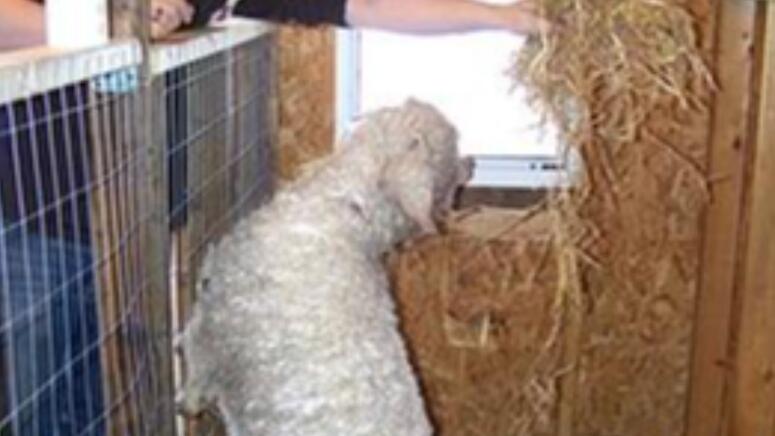Posted by Jennifer Sartell, Professional Homesteader & Blogger, Mon, Mar 2, 2015
Nutrition
Pregnant does and does in milk have different nutritional needs than young does, bucks, and wethers. Protein plays an important role in the health of a doe. There are different ways in which you can increase protein levels in your feed. One way is to include alfalfa hay in their diet. We also like to increase their grain ration by 25%.
We do this slowly and include a probiotic and access to baking soda to help maintain balance in the rumen. You can also supplement the grain mix with sunflower seeds or beet pulp pellets. Sunflower seeds are especially healthy for fiber-producing goats.
Goat Mineral
All goats should have access to minerals at all times. Provide free-choice access to a good-quality mineral, but manage mineral feeding for appropriate intake. We offer Manna Pro® Goat Mineral, a loose mineral that our goats prefer over the block types.
One mineral that is especially important to pregnant does is selenium. Check with your county extension agent to find out if the soil in your area is selenium deficient. If it is, you will have to supplement your doe (and the kids, for that matter) with additional selenium beyond their usual mineral supplement. Check labels or consult your veterinarian regarding the correct dosage, as too much selenium can be harmful. When offering any mineral supplement, be sure to always have fresh water available at all times.
Drying Off
Around 60 days into a doe’s pregnancy, we begin to dry off our milking does. Drying off is the process of stopping your goat from lactating. It’s important to dry off your goat from her last freshening so that her body can concentrate its efforts on the current pregnancy. We wean our girls slowly over several weeks.
We do this by lengthening the time between milkings from 12 hours to 13, 14, 15 and so on, increasing the span by an hour each day. If you wean in this manner, you will notice that after a while her milk production begins to drop. Eventually we get her to one milking a day and then every other day, and eventually she is creating very little milk. By weaning in this manner, we’ve never had a case of mastitis and never had to administer antibiotics.
Preparing Her for Birth
Setting Up the Birthing Stall
The birthing stall should be clean and draft free. We fill it with fresh, soft straw and give the doe her own water, feed dish, mineral pail, and hay trough. It’s also a good idea to set up a heat source if the weather is still chilly. A heat lamp or electric warming pad works very well for newborn kids. Be sure to secure all heating elements and cords away from curious goats to prevent electrocution and fires.
We separate our girls from the herd when they’re very close to birthing, with the exception of our two Nubian sisters who become very stressed when separated. You’ll have to decide what’s right for your goat and her personality. Separation allows the dam to concentrate on her babies and rest without being disturbed. It also makes things easier for us so we can care for the doe without extra “helpers.”
About two weeks before she’s due, we worm our doe with a pregnancy-safe wormer such as Manna Pro Positive Pellet® Goat Dewormer. We also trim her hooves and shave her udder and tail area. Be sure to use clippers meant for animals; otherwise, you might have a tough time of it. If it’s a fiber goat, we shave the whole rear end.
When your goat is getting very close to delivering, she might begin nesting by pawing at the ground, turning in circles, and lying down and getting back up. Check her pin bones at the base of her tail for softening; if they are softened, she will give birth within 24 hours.
I wish you all the best with your pregnancies and births this spring. Check back often to find more articles on kid births, caring for newborns and much more!
Author Profile: Jennifer Sartell
Jennifer Sartell is the primary caretaker of all animals on her and her husband’s farm in Fenton, MI. With a passion for living a simple life, Jennifer enjoys creating art, taking in nature, raising animals and has developed a deep appreciation for homesteading. Jennifer and her husband, Zach, currently raise goats and poultry.
Her vast amount of experience on the farm includes, but is not limited to: milking, shearing, hoof trimming, vaccine administration, assisting in animal births, dehorning, egg collecting, chick and turkey hatching, feeding, watering, etc. She can also cook a mean farm-to-table meal and when the day is done has documented and photographed their day on the farm.
More Blogs by Jennifer Sartell
- https://www.mannapro.com/homestead/caring-for-pregnant-does-part-2
- https://www.mannapro.com/homestead/caring-for-pregnant-does-part-1
- https://www.mannapro.com/homestead/preparing-caring-for-goats-in-winter
- https://www.mannapro.com/homestead/dairygoatbreeds
- https://www.mannapro.com/homestead/preparing-the-kidding-stall-part-2
- https://www.mannapro.com/homestead/a-guide-to-buying-a-new-goat
- https://www.mannapro.com/homestead/raising-kids-dehorning-wethering
- https://www.mannapro.com/homestead/milking-a-goat
- https://www.mannapro.com/homestead/raising-fiber-goats-101
- https://www.mannapro.com/homestead/hoof-care-for-goats
- https://www.mannapro.com/homestead/putting-together-a-goat-birthing-kit
- https://www.mannapro.com/homestead/preparing-the-kidding-stall-part-1
- https://www.mannapro.com/homestead/breaking-down-the-goat-diet
- https://www.mannapro.com/homestead/birthing-goat-kids
- https://www.mannapro.com/homestead/dealing-with-goat-scours
- https://www.mannapro.com/homestead/feeding-baking-soda-to-your-goats
- https://www.mannapro.com/homestead/pros-cons-and-facts-about-raising-turkeys
- https://www.mannapro.com/homestead/best-breeds-for-raising-chickens-with-children
- https://www.mannapro.com/homestead/a-guide-to-small-goat-breeds


